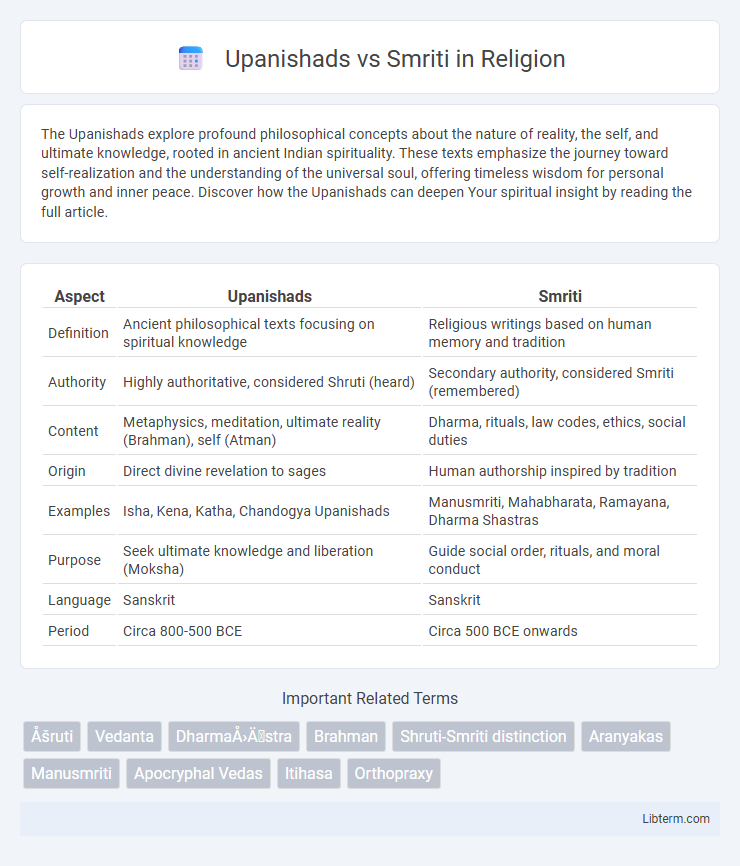The Upanishads explore profound philosophical concepts about the nature of reality, the self, and ultimate knowledge, rooted in ancient Indian spirituality. These texts emphasize the journey toward self-realization and the understanding of the universal soul, offering timeless wisdom for personal growth and inner peace. Discover how the Upanishads can deepen Your spiritual insight by reading the full article.
Table of Comparison
| Aspect | Upanishads | Smriti |
|---|---|---|
| Definition | Ancient philosophical texts focusing on spiritual knowledge | Religious writings based on human memory and tradition |
| Authority | Highly authoritative, considered Shruti (heard) | Secondary authority, considered Smriti (remembered) |
| Content | Metaphysics, meditation, ultimate reality (Brahman), self (Atman) | Dharma, rituals, law codes, ethics, social duties |
| Origin | Direct divine revelation to sages | Human authorship inspired by tradition |
| Examples | Isha, Kena, Katha, Chandogya Upanishads | Manusmriti, Mahabharata, Ramayana, Dharma Shastras |
| Purpose | Seek ultimate knowledge and liberation (Moksha) | Guide social order, rituals, and moral conduct |
| Language | Sanskrit | Sanskrit |
| Period | Circa 800-500 BCE | Circa 500 BCE onwards |
Introduction to Upanishads and Smriti
The Upanishads are ancient Indian texts that explore spiritual knowledge, metaphysics, and philosophical concepts central to Hinduism, forming the basis of Vedanta. Smriti literature, including epics like the Mahabharata and Dharma Shastra texts, serves as remembered tradition offering guidelines for law, ethics, and social conduct. While the Upanishads emphasize inner knowledge and the nature of reality, Smriti codifies practical rules and societal norms for daily life.
Historical Origins and Evolution
The Upanishads, composed between 800 and 500 BCE, represent the philosophical and mystical teachings of the Vedic tradition, forming the core of Shruti texts considered divinely revealed and eternal. In contrast, Smriti texts, including the Dharma Shastras and Puranas, emerged later, around 500 BCE to 500 CE, as canonical scriptures codifying social laws, ethics, and customary practices, and are regarded as human-authored and adaptive. The evolution of Upanishads laid the foundation for Vedantic philosophy, while Smriti texts evolved dynamically to guide everyday religious and societal conduct within the framework established by the eternal Shruti.
Philosophical Foundations: Upanishads
The Upanishads represent the core philosophical foundations of Hinduism, emphasizing metaphysical concepts such as Brahman (the ultimate reality) and Atman (the individual soul). These texts explore the nature of existence, self-realization, and the pursuit of spiritual knowledge, forming the basis for Vedantic thought. Unlike the Smriti, which is more prescriptive and ritualistic, the Upanishads prioritize introspection and philosophical inquiry.
Philosophical Foundations: Smriti
Smriti texts, including the Dharma Shastras and Puranas, serve as practical guides rooted in the philosophical foundations of Dharma, Karma, and societal duties reflecting human conduct aligned with Vedic principles. Unlike the Upanishads, which emphasize metaphysical knowledge and self-realization (Atman and Brahman), Smriti texts focus on the application of these philosophies in daily life, ethical behavior, and ritualistic traditions. Their authority comes from their role in codifying social norms and ethical laws that sustain the cosmic order (Rta) within the framework of Hindu philosophy.
Core Teachings and Doctrines
The Upanishads emphasize metaphysical knowledge and self-realization, focusing on concepts like Brahman (universal soul) and Atman (individual soul) as the ultimate reality. Smriti texts codify dharma, social laws, and rituals, providing practical guidelines for daily living and moral conduct based on societal norms. Together, the Upanishads and Smriti balance spiritual insight with structured ethical behavior in Hindu philosophy.
Scriptural Authority and Significance
The Upanishads hold primary scriptural authority in Hindu philosophy, representing Shruti texts revealed directly to ancient sages and emphasizing metaphysical knowledge and self-realization. In contrast, Smriti texts, including the Dharma Shastras and Puranas, serve as secondary scriptures derived from human authorship, codifying practical laws, rituals, and social duties. While the Upanishads establish foundational spiritual concepts, Smriti texts guide everyday conduct and societal norms, together shaping the comprehensive framework of Hindu religious practice.
Interpretations and Commentaries
The Upanishads, considered shruti texts, invite diverse interpretations emphasizing philosophical concepts such as Brahman and Atman, fueling extensive commentaries by scholars like Adi Shankaracharya who elucidated non-dualism through Advaita Vedanta. In contrast, Smriti texts, including Dharma Shastras and Puranas, offer prescriptive content subject to contextual adaptations, resulting in commentaries that reflect evolving social and legal norms over time. The interpretative tradition of Upanishads centers on metaphysical inquiry, while Smriti commentaries prioritize practical guidance for societal conduct and ritual practice.
Influence on Hindu Practices
The Upanishads serve as foundational scriptures that deeply shape Hindu philosophical thought and spiritual practices, emphasizing meditation, knowledge (jnana), and the inner self (atman). Smriti texts, including the Dharma Shastras and Puranas, provide practical guidelines and codified rituals that govern daily worship, social conduct, and ceremonial duties within Hinduism. Together, the Upanishads inspire the metaphysical framework, while Smriti texts influence the lived religious practices and community norms among Hindus.
Comparative Analysis: Upanishads vs Smriti
The Upanishads, regarded as Shruti texts, emphasize philosophical insights, metaphysical concepts, and self-realization, forming the core of Vedic wisdom, whereas Smriti texts like the Manusmriti and Dharma Shastra serve as practical guides for social conduct, rituals, and law, reflecting societal norms and duties. Upanishads convey eternal truths through dialogues and meditative inquiry, focusing on Brahman and Atman, while Smriti codifies customs and legal principles for everyday life, evolving with communities over time. The authority of Upanishads is considered divine and canonical, whereas Smriti is human-authored and adaptable, highlighting their complementary roles in Hindu tradition.
Contemporary Relevance and Legacy
The Upanishads, foundational texts of Hindu philosophy, continue to influence contemporary spiritual and philosophical thought through their emphasis on self-realization and metaphysical inquiry. Smriti literature, which includes texts like the Dharmashastras and Puranas, remains relevant in shaping ethical norms, social laws, and ritual practices in modern Hindu society. The enduring legacy of both texts lies in their complementary roles: the Upanishads foster introspective wisdom, while Smriti provides practical guidance for living an organized and righteous life.
Upanishads Infographic

 libterm.com
libterm.com